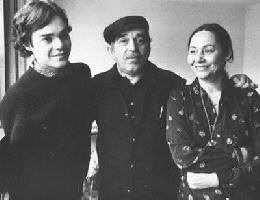
Reading Cien Años de Soledad. I started to wonder what Gabriel Garcia Marquez's family was like. I wondered how much of this book reflected his own ancestry, so I did a little investigating and I found a story of his parents meeting, which started with a beautiful description of his mother, and also gave some insight into the size of his family... "My mother became a woman in a godforsaken hellhole. She had spent an uncertain childhood plagued by malarial fevers, but, once cured, she was cured completely and forever, and with her health as strong as reinforced concrete she was able to celebrate her ninety-fifth birthday with eleven of her own children, and four of her husband's, and sixty-six grandchildren, seventy-three great-grandchildren, and five great-great-grandchildren. Not counting the ones nobody ever knew about" (Serenade: How my Father Won my Mother 2001 The New Yorker
As Marquez says, "Serenade" is about of how his parents came to be married and Love in the Times of Cholera is a based on his parents courtship. However, I did notice some similarities between his parents world and the world of the Buendía family:
First of all, like Ursula and José Arcadio Buendía, Marquez's mother's parents also moved away from a town due to her father having killed another man, "
I thought this quote about his own family was interesting and reflects a little on the Buendía family, "This atavistic prejudice, whose embers still linger, has turned us into a vast family of men with their flies open and unmarried women with numerous children in the street."
I also noticed that, in the Buendía family, most of the women are incredibly strong, especially Ursula and thought that this quote from "Serenade", about his mother, explains his the strength of character his females have in his novels. Here he describes his mothers sudden shift from daughter to a strong and wilfull woman "And she, who had been obedient and submissive, confronted her opponents with the ferocity of a lioness who has just given birth."
This quote reminded me of Amaranta's burnt hand, though it's not the same circumstances, they are very similar, "In the most corrosive of their many domestic disputes, Mina lost her temper and threatened her daughter with the bread knife. An impassive Luisa Santiaga stood her ground. Suddenly aware of the criminal implications of her wrath, Mina dropped the knife and screamed in horror, "Oh, my God!" And placed her hand on the hot coals of the stove in brutal repentance."
Marquez describes his father's mother, Argemira Garcia Paternina, and it reminded me of Pilar, (except for the physical description), "she was a slender white girl with a joyous nature and a free spirit, who went on to have six more children, by three different fathers."
And this quote reflects the politics of Cien Años, "The family's opposition to Gabriel Eligio was even more ferocious because he was an active Conservative, a member of the party against which Colonel Nicolás Márquez had fought his wars." This story can be found on this website, it's very good and if you have read Love in the Times of Cholera, you will probably see similarities between it and his parent's story as well: http://www.themodernword.com/gabo/gabo_serenade.html
4 comments:
I had no idea that Gabriel Garcia Marquez's family was so very similar in complexity and in numbers to the Buendia family. It is more or less certain, as you mention in your blog, that many of the events in the novel are based on true occurances such as Amaranta putting her hand in hot coals. I suppose it makes a lot of sense though, because coming up with a brilliant and convoluted story like Cien Anos would be nearly impossible without having had some similar past experiences.
I always find your comments interesting especially when you go above and beyond to try to find information that will be relevant to the readings. I do agree with you about the strength that the woman of this novel posses. However, there is another characteristic that comes to mind when describing them, stubborn. Stubbornness can sometimes be confused with strength but I would definitely include stubborn in my description of these woman.
I'm not sure that in this case stubbornness is confused with stregth. Rather, it seems that Marquez himself includes stubbornness in his notion of female strength. Thoughts?
Mikeal, I agree. I think his female characters (discluding Amaranta) are both strong and stubborn, and Marquez realized that they needed to be just to be heard in a society where they were expected to sit in the shade and embroider all day. I think Marquez's notion of a strong women includes stubbornness, and rightly so. He grew up in a Macho world where women needed to adopt a less subtle approach to dealing with certain issues in order to be taken seriously. Though, I don't think Amaranta was so strong, but certainly stubborn.
Post a Comment